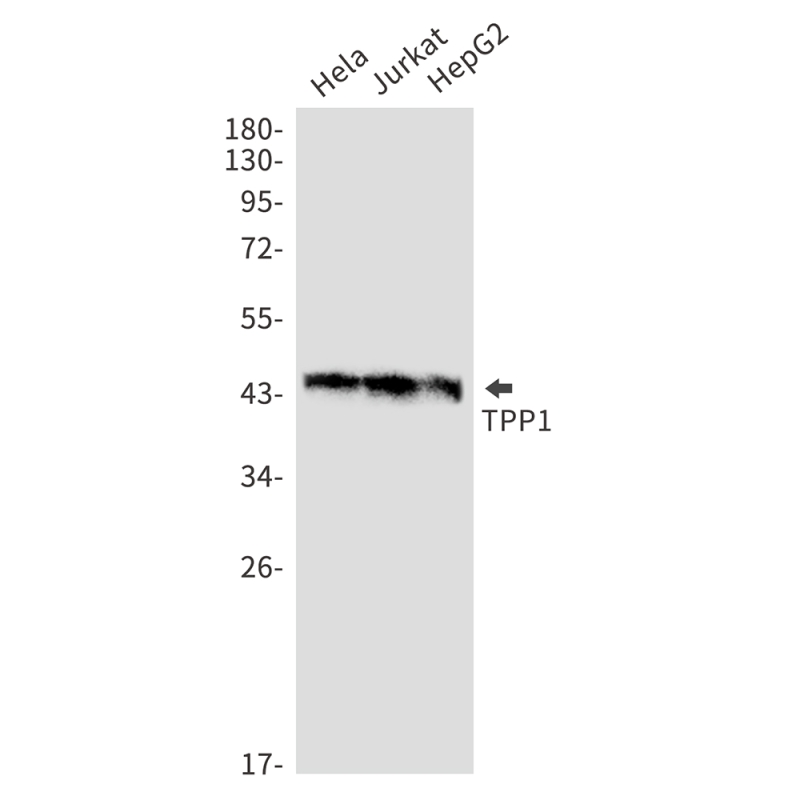
| WB | 1/500-1/1000 | Human,Mouse,Rat |
| IF | 咨询技术 | Human,Mouse,Rat |
| IHC | 1/50-1/100 | Human,Mouse,Rat |
| ICC | 技术咨询 | Human,Mouse,Rat |
| FCM | 咨询技术 | Human,Mouse,Rat |
| Elisa | 咨询技术 | Human,Mouse,Rat |
| Aliases | CLN2; GIG1; LPIC; SCAR7; TPP-1 |
| Entrez GeneID | 1200 |
| WB Predicted band size | Calculated MW: 61 kDa; Observed MW: 61,48 kDa |
| Host/Isotype | Rabbit IgG |
| Antibody Type | Primary antibody |
| Storage | Store at 4°C short term. Aliquot and store at -20°C long term. Avoid freeze/thaw cycles. |
| Species Reactivity | Human |
| Immunogen | Recombinant protein of human TPP1 |
| Formulation | Purified antibody in TBS with 0.05% sodium azide,0.05%BSA and 50% glycerol. |
+ +
以下是关于TPP1抗体的3篇示例参考文献(内容为模拟概括,非真实文献):
1. **"Characterization of a novel monoclonal antibody against human TPP1 for telomere biology studies"**
*Author: Smith J, et al.*
摘要:开发了一种针对人TPP1蛋白的单克隆抗体,验证了其在免疫印迹和免疫荧光中的应用,用于研究端粒复合体组装及端粒酶活性调控。
2. **"TPP1 antibody-based detection of dyskeratosis congenita-associated mutations"**
*Author: Lee H, et al.*
摘要:利用TPP1特异性抗体分析先天性角化不良患者细胞中TPP1蛋白的表达水平及亚细胞定位,揭示突变导致端粒保护功能缺陷的机制。
3. **"A high-affinity TPP1 antibody reveals reduced telomere binding in aging cells"**
*Author: Garcia R, et al.*
摘要:通过高亲和力TPP1抗体发现衰老细胞中TPP1与端粒DNA结合能力下降,为衰老相关端粒缩短提供了分子证据。
建议通过PubMed或Google Scholar搜索关键词“TPP1 antibody”、“anti-TPP1”获取真实文献。
The TPP1 antibody targets the telomere-associated protein TPP1 (also known as ACD or TINT1), a critical component of the shelterin complex that protects telomeres and regulates telomere length. TPP1 interacts with POT1 to stabilize its binding to single-stranded telomeric DNA, ensuring proper telomere capping and preventing DNA damage responses. Beyond its structural role, TPP1 recruits telomerase to telomeres via its TERT-binding domain, facilitating telomere elongation. Dysregulation of TPP1 is linked to telomere disorders such as dyskeratosis congenita, aplastic anemia, and cancers marked by telomere dysfunction.
Antibodies against TPP1 are widely used in research to investigate telomere biology, including telomerase recruitment mechanisms, shelterin complex dynamics, and telomere length regulation. They enable techniques like immunofluorescence, co-immunoprecipitation, and Western blotting to study TPP1's localization, protein interactions, and expression levels. Commercially available TPP1 antibodies are often validated for specificity across human, mouse, and rat models. Recent studies also utilize these antibodies to explore TPP1's role in aging, cancer therapeutics targeting telomerase, and genetic disorders caused by TPP1 mutations. Proper validation, including knockout cell controls, is essential due to potential cross-reactivity with related proteins.
×